Monthly 1k - Noah Kagen
Most Important Lessons:
- Overcome your fears
- Limit the time for action (48hrs for validation)
- Parkinson's law - velocity is important!
- maintain momentum - do this, or do nothing
- Generate ideas broadly
- search for ideas, go to where your audience lives (reddit, forums, twitter, youtube)
- business ideas
- Test frameworks for validation
- lowest-hanging fruit!
- speak to people is quicker than building something (what's the worst that can happen?!)
- sketch is quicker than a landing page
- Identify highest-order problems (high-totem)
Fears and Excuses
Wantrepreneur Fears - Google Docs
Excuse #1: “I don’t have any good ideas”
Excuse #2: “But I want to start a big business, not be a freelancer”
Excuse #3: “I don’t have the time”
Excuse #4: “I don’t have the energy”
Excuse #5: “Everyone’s going to make fun of me”
Excuse #6: You’re waiting for permission
Excuse #7: “I’ll do it tomorrow”
Commandments
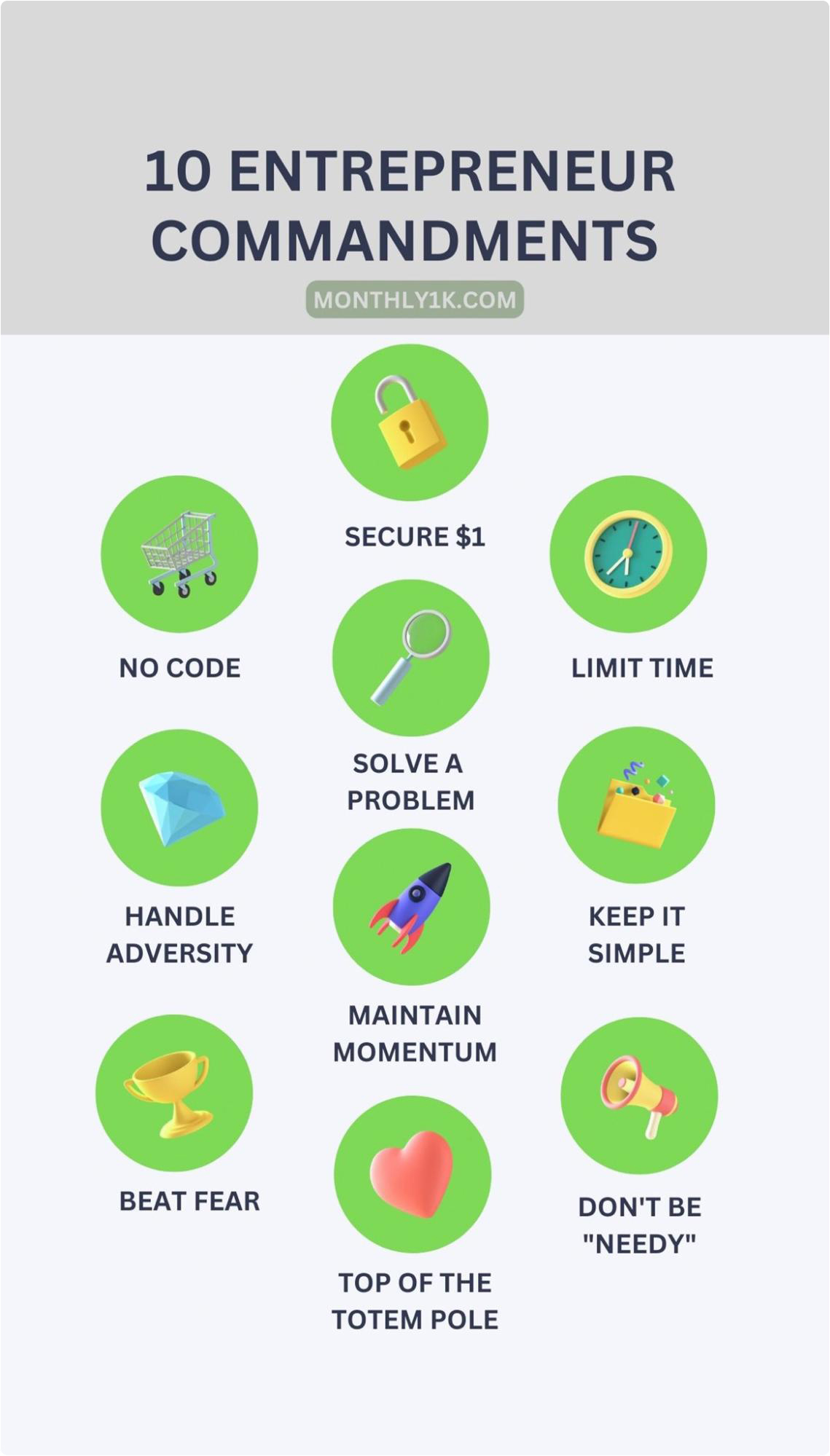
Commandment #1: No Code
It's so much easier to build something and hope to find customers than to make sure people actually want what you’re making.
It feels good to be building something, behind the scenes, that no one will see
When I was at UC Berkeley, I assumed every student would want to have a Craigslist for their school. I hired a developer and a designer and spent a few months building CollegeUp.
After a few delayed months of development, we launched the site…
And no one came.
Sound familiar? Lots of people struggle with having no traffic when they launch.
We then proceeded to add more features assuming that would solve our problems.
Here’s what it looked like…
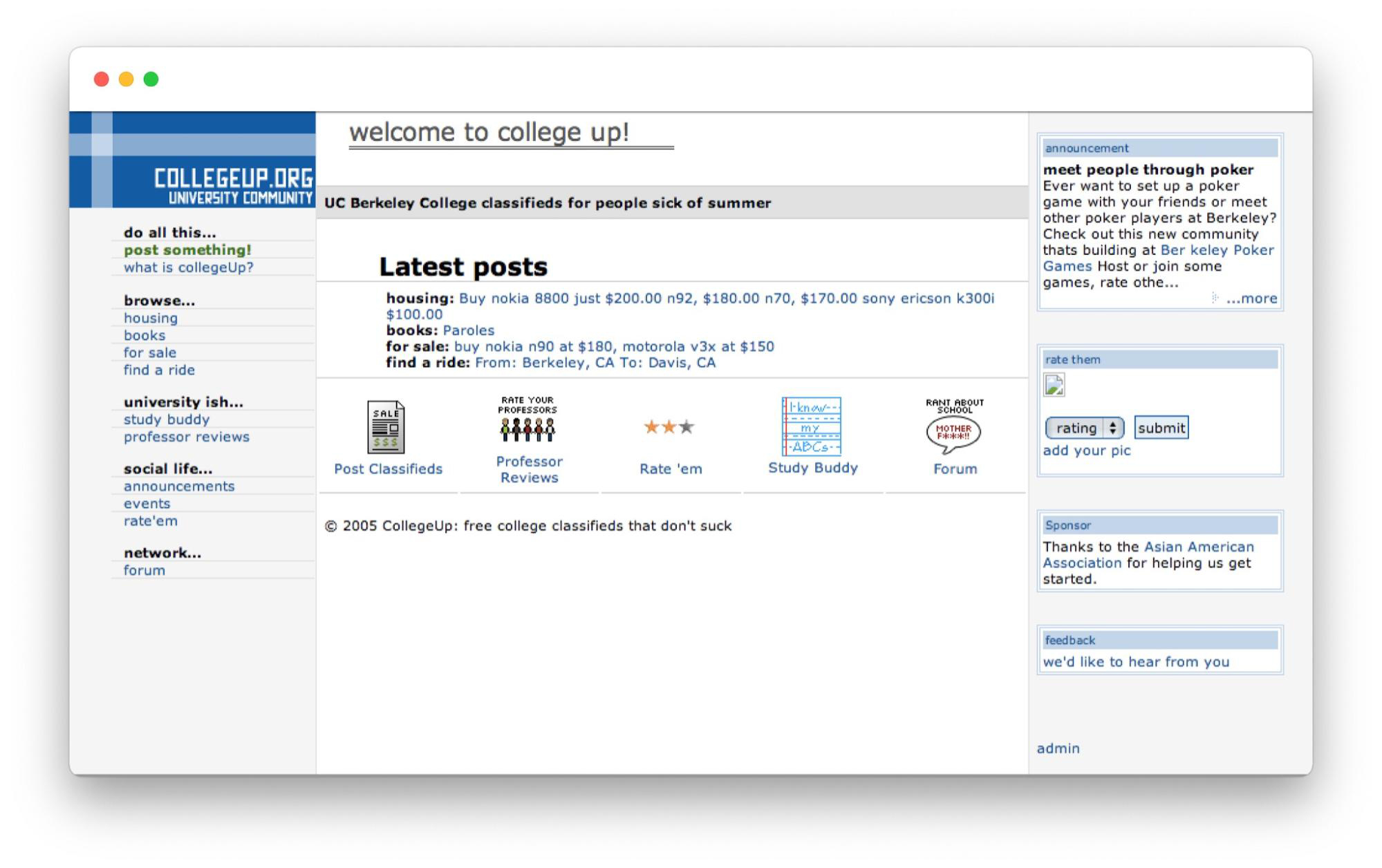
(Spoiler alert: It didn’t solve our problems.)
What would have solved our problems, is if we had launched the business like Craigslist started (with an email list—hence “Craigs_list”) _so we could have figured out if students wanted our service or not by getting them to sign up to our email list.
No one interested to sign up to your email list = no one interested in buying your product or service.
-
repeat that: if no one is interested in your email list, then no one gives a fuck about your product or service!
That’s why the #1 commandment around here is NO CODE.
==Start with validation first: ==
- email subscribers,
- Twitter followers,
- people actually giving you cold hard cash
... then go build the product or service.
And I can hear all you SaaS entrepreneurs saying...
"I’m starting an app or a tool or a website or a whatever and I NEED to code."
No, you don’t.
SaaS stands for Software as a Service.
You need the service first BEFORE the software even exists. So, find a way to offer the service without coding anything and investing a ton of time and energy!
Once you know people want the service and will pay for it, then you can make ALL apps and websites your heart desires!
Commandment #2: Keep it Simple
This is another example of why apps and websites are your biggest hurdle in the beginning.
You think you need an app.
You think you need a website.
No!
What you NEED is a business.
And, you don’t need either of those things to have a business.
For thousands of years, businesses existed without apps and websites. Yours can too—at least at the beginning.
Let go of the “dead-lock” requirement of having an app or website and focus on the real thing that customers want in the simplest way possible.
- What would it look like if you had to convert your app idea to a paper product?
- What would your business website look like if it was just a hand-drawn sign?
See if you could answer one of those things RIGHT NOW.
Simplify your business idea to the complete bare bones.
Keep it simple. Keep it moving.
Commandment #3: What’s the Problem?
Avoid creating a solution for a problem that doesn’t exist.
That can work, but it makes it much harder to be successful.
This is a setback endemic to people who love to build but avoid talking with people (AKA, potential customers). It creates a worst-case scenario where you build a fully-fledged product that no one wants, much less needs.
Instead, look for problems and work backward from there to solve them and find your business.
I spent 6 months, $50,000+, and hired a high-priced Vegas lawyer to build BetArcade which I thought was going to be THE destination for fantasy sports betting.
Here’s what it looked like…
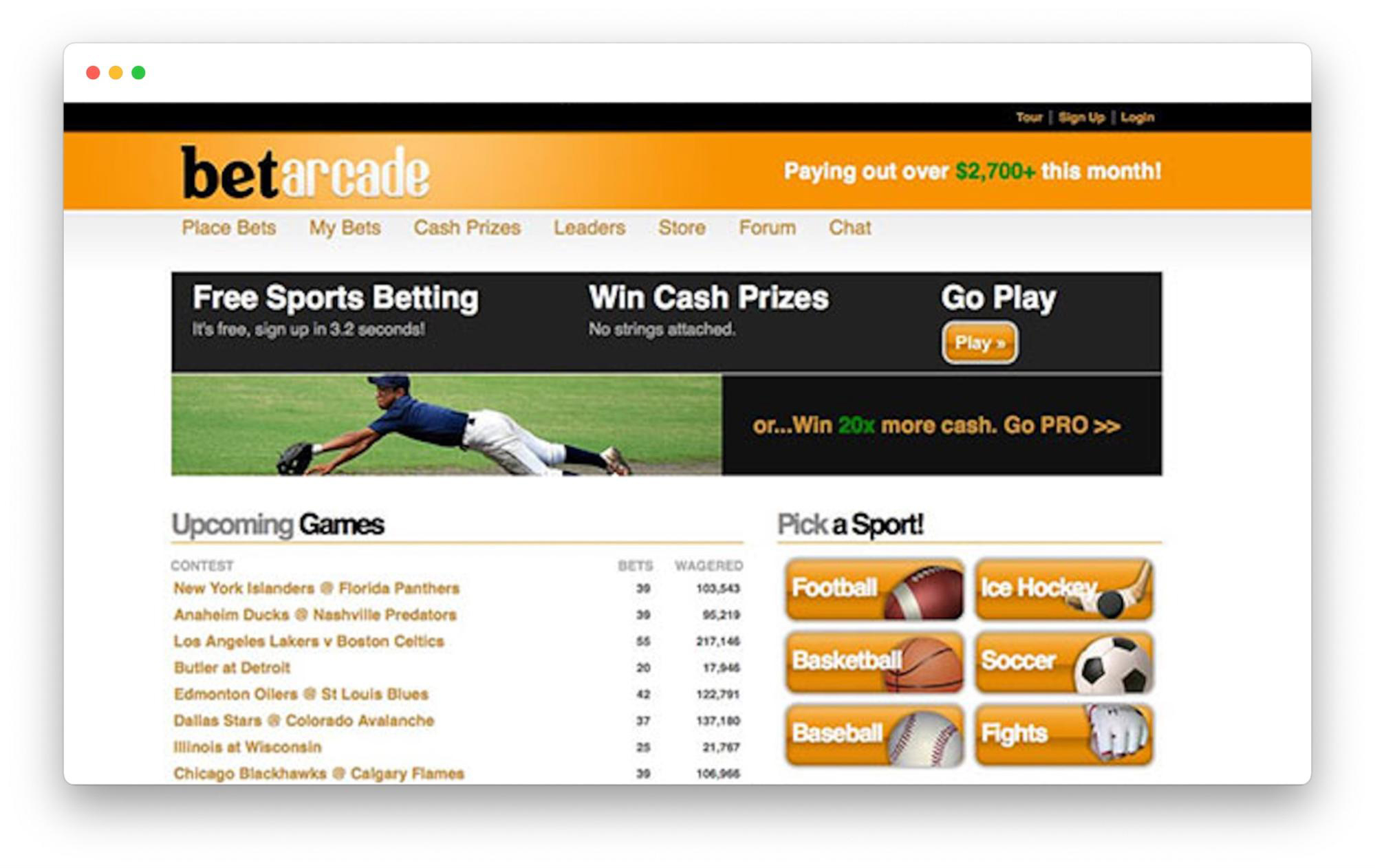
I KNEW people would love the service and pay for it in droves.
Yet, when we launched, it was complete crickets.
I never spent the time making sure people wanted to play online fantasy sports in that way.
Expensive lesson learned!
Validate your assumptions. Validate your business. Talk to people first. Then, build.
Validate.
Validate.
Validate.
Commandment #4: Find Your Place on the Totem Pole
Think of a totem pole as a measurement of how important you are to your customer.
Ranking high up on the totem pole means that the customer really needs you.
Ranking low on the totem pole means your products and services are “nice to have.”
A business exists to offer a solution to a problem. Make sure the problem you’re solving is something people think about when they wake up in the morning.
Otherwise, if your business goes away, people's lives will be worse off.
If you aren’t solving a high-totem-pole problem, it will be much more difficult for your business to succeed.
Solve high-totem problems!
When I first heard about Mint.com (free automatic finance tracking) I was blown away. In terms of a totem pole, this was at the top of the charts:
- Helps people manage their money without any work
- Totally free
- TONS of people have this problem
Compare this to Mint's competitors who focused on having people manually enter their information and charged for the service.
They’re similar, but a few differences put Mint at the top of customers’ totem poles, and their competitors at the bottom.
Commandment #5: Don't Be “Needy”
This is when you want things like business cards, LLC papers, other useless tools, etc. before you can move on.
If this is you 'pre-profitable', then you have a serious issue!
-
! STOP putting barriers on yourself and stop worrying about the WRONG things.
-
I need a co-founder: NO! You can figure it out on your own to start and hire people later.
-
I need to wait for the designer to finish: NO! Finish it yourself or use something else. Keep it simple.
-
I need funding: NO! You’re not putting a ton of time and money into it to get started, remember? We’re not coding and we’re keeping it simple. Use what you have and get funding from your customers as you validate.
-
I need to learn marketing: (you already know this!) NO! Learn as you go. Validating your product ideas is a form of marketing. Plus, you can do it all word-of-mouth to get started.
-
I need to find a developer: see: Commandment 1 - NO! We’re not coding, remember? Make a minimum viable product (MVP), even if that means drawing something on paper.
see also:: 1. Fears and Excuses
Do you really need any of those or can you figure out another way around it?
Entrepreneurship is solving problems.
There are ALWAYS more problems!
So, why create more for yourself?!
Instead, deconstruct and reduce problems, remove obstacles and find your path forward!
The freshest untracked powder is the most enjoyable skiing!
I've signed up to a few no-code reddit channels:
- Product Launch Post : r/nocode
- No Code
- Software As a Service Companies — The Future Of Tech Businesses
- Maker/Entrepreneur CheatSheet of Low-Code/No-Code Applications and Courses : r/NoCodeMovement
There are incredible resources that others have built so you can launch quickly, knowing no code!
eg.
would you make digital music without a DAW?
code it yourself? - no!
Use the damn DAW!
Commandment #6: Maintain Momentum
momentum can be your most powerful ally or biggest foe when starting a business.
The more momentum you have, the easier it is to maintain.
The less you keep up momentum, the harder it is to generate every time you need it again.
inertia sets in and prevents you from moving.
That’s why it’s especially important to keep going when you encounter problems in the beginning.
If you give up every time your plans are hampered, it will be harder to restart the next time.
Be aware that how you approach other things in life is how you’ll approach your business.
Even if you approach this course with momentum—that’ll translate over to how you approach your business.
how you do anything, is how you do everything
Eventually, the momentum will lead to an "aha" moment when people want what you’re offering, and that comes from continually doing at least one small thing each day.
When I first started at Facebook, everyone was still on Myspace. Remember those days?
My mom would call me every day, mentioning how Myspace was being talked about on Oprah and how she'd heard reports of its popularity.
That was a big hurdle for us at Facebook.
We needed to build momentum to get over it!
What we did was focus on daily momentum.
Our goal each day was to get more signups than the day before.
That helps EXTREMELY well on the days when things aren't going as well, and even better on days when we had insane growth.
Over time, that momentum paid off and Facebook became the #1 app in Social Networking. (And got a movie!)
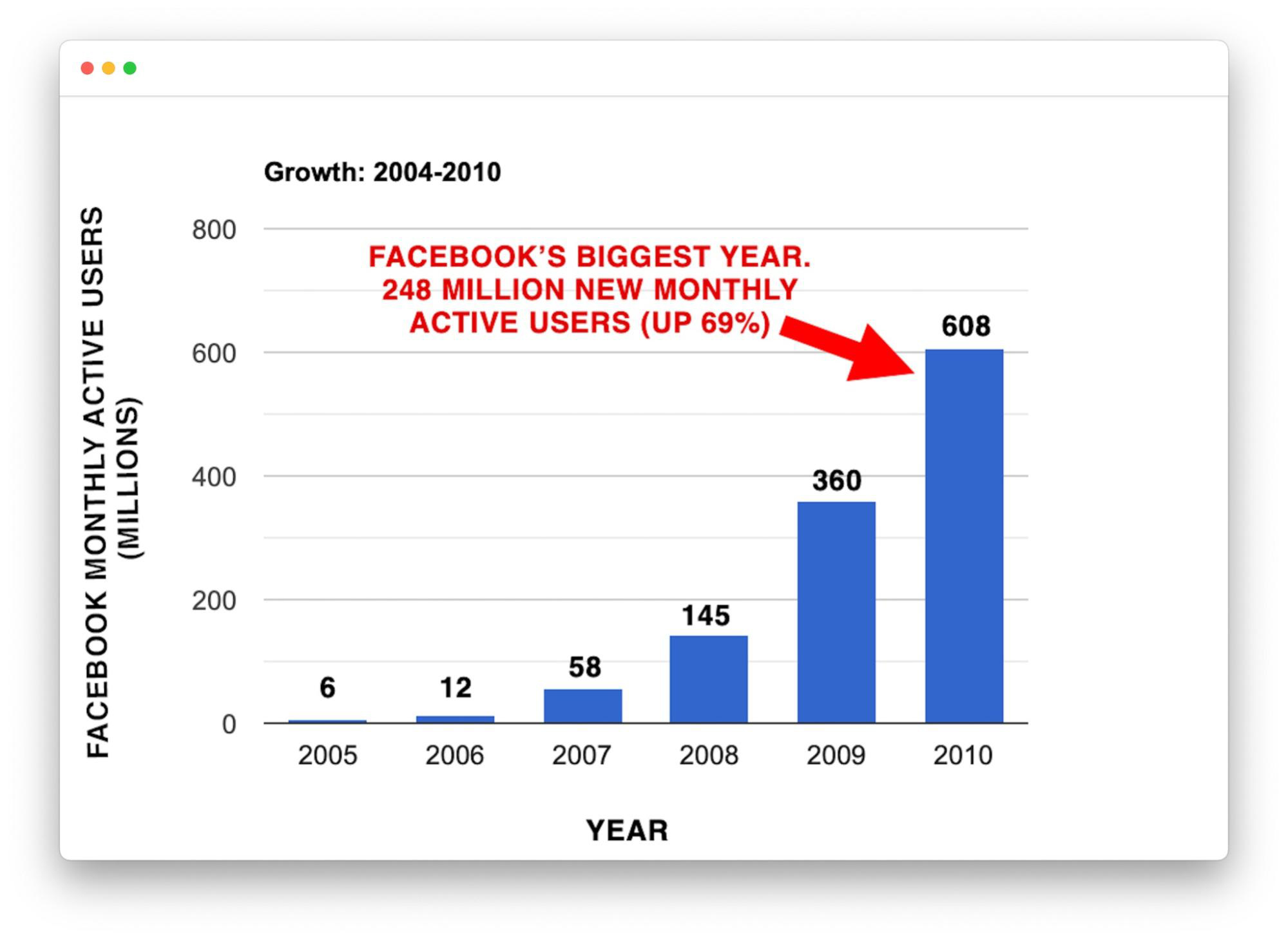
Just think of the phrase, "One thing at a time."
You can do everything you want, but choose one at a time
Start that momentum and then just slowly keep it going.
Activity
What's one tiny habit you can begin today?
(five pushups, read for five minutes, five more minutes of this course, etc...)
Flex your momentum muscle!
-
Write it down and schedule it in your calendar.
Commandment #7: Use Time Limitations
Limiting the time you put into starting your business will not only save you time and money, but it’ll also boost your creativity.
Parkinson's law says:
"a task will swell in (perceived) importance and complexity in relation to the time allotted for its completion."
“Work expands so as to fill the time available for its completion.”
In other words, if I give you 24 hours to complete a project, the time pressure forces you to focus on execution, and you have no choice but to do only the bare essentials.
It’s the magic of the imminent deadline.
So when starting your business, do it in a weekend instead of a month.
NOW not how
Whatever you have done by the end of the weekend - that’s what you launch with. It won’t be perfect, but that’s okay.
-
A business launched imperfectly is better than a perfect business never launched at all.
Commandment #8: Velocity to $1
I know we went over this at the beginning of the course, but this is A BIG ONE.
I can remember when I started NinjaCard (a college discount card) and made my first $9 in profit. As I put the discount card in the envelope to mail out, I recall thinking, "I’m actually running my own business".
Once you reduce all barriers and get to your first $1, that will open your eyes and create excitement to continue.
Is that how you felt when you asked friends, family members, and maybe even strangers at the beginning of this course for $1? Or did you feel bad, unworthy, and crummy about it?
Or did you completely avoid asking anyone at all, and just continued on with the course?
For those people, here’s your chance again.
Ask someone for $1. Just $1.
I promise you, once you get it—your whole mindset changes. And the way it does that is by shifting your thinking to “How am I really going to get this business working?” versus playing business or dreaming about it.
And if you get rejected along the way, that’s cool too! Rejection is redirection. Tell that person that you appreciated their time and consideration, and ask someone else.
The only way to “fail” at this is to not ask anyone at all.
Commandment #9: Handle Adversity
A true entrepreneur will figure things out.
- You don’t have a business partner? Do it yourself.
- Can’t get funding? Do it for free or ask customers to pre-order.
- You don’t have the time? Hire someone, or ask a friend to help out.
The point is that everything is figure-outable if you want it to be.
Everything is Figureoutable - Marie Forleo
One day, I woke up with a bunch of calls from lawyers. They were asking if I wanted to use their services.
Huh?
That day, my company Gambit was getting sued by its largest (and most heavily funded) competitor since we were kicking their ass. Then a few weeks later, our company also got banned by Facebook—which was where 90% of our revenue was coming from.
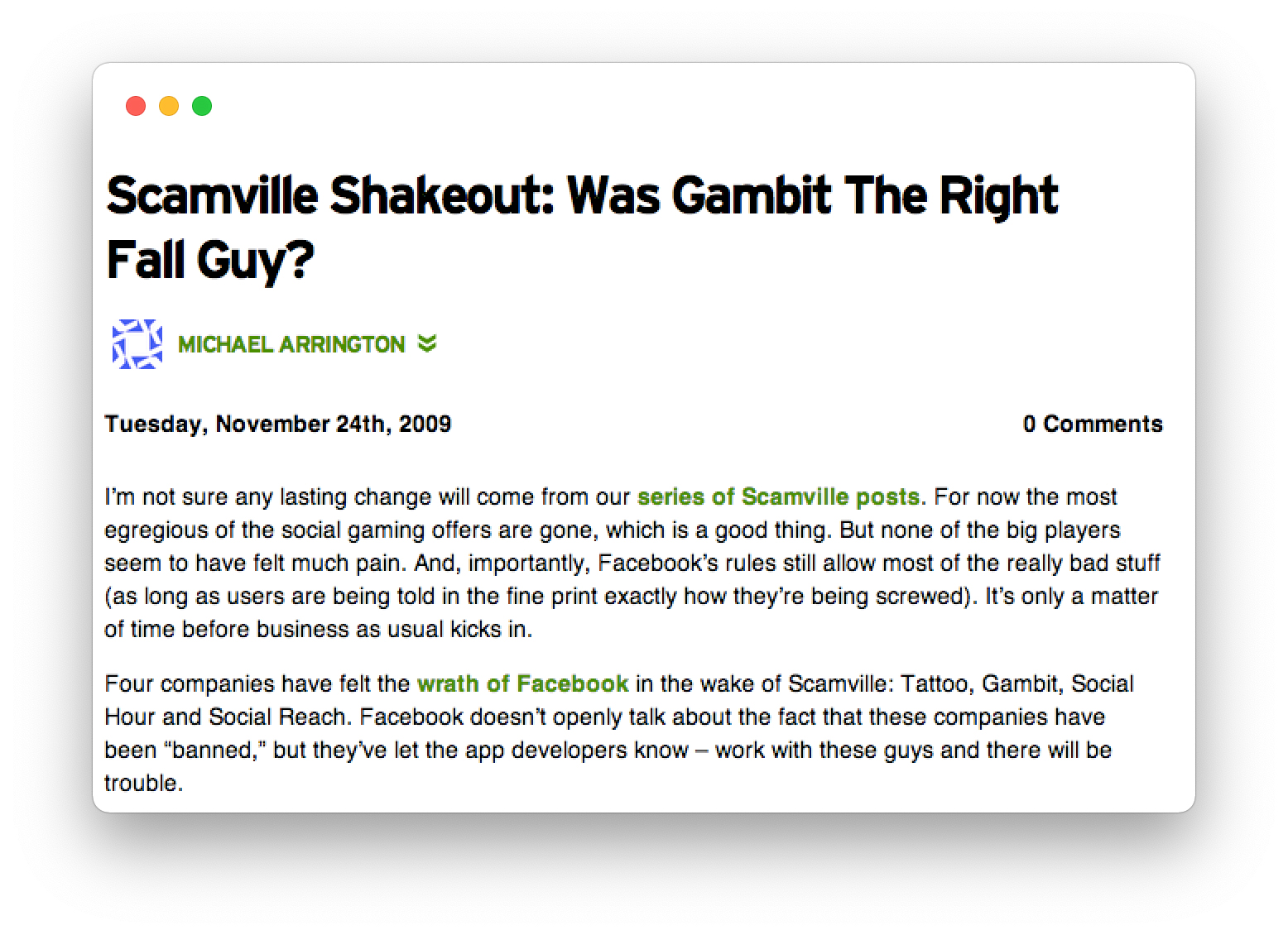
Talk about a challenging month.
There will be a time when you will be challenged. How you persevere is what will separate you from everyone else.
For me, we settled the lawsuit out of court and the company shifted towards video advertising instead of Facebook payments, which is still running strong today.
Commandment #10: Don’t Ignore Your Fears
I went ATV-ing for my brother’s bachelor party and there was a deathly steep hill.

I was scared. I knew if I faced this fear, I would become stronger (and it may actually be fun).
Eventually, I told myself I wouldn’t leave the mountain until I did it.
YOLO!
Finally, I was at the lip of the mountain and peered over the edge… Then I turned the throttle and started going down… My heart was racing and I gripped the handles tightly.
Near the bottom, the adrenaline slowed down and I started smiling because… I did it! Then I proceeded to go down some of the tallest mountains all day long and it was AWESOME.
It was a great lesson that facing my fears wasn’t as scary as I imagined.
Starting a business might feel like you’re teetering over the edge of a tall mountain. And you might have to convince yourself to take the plunge—but it’s possible.
And it certainly will be worth it. Even if it’s just to prove to yourself that you can do it.
feel the fear and do it anyway
revisit: Wantrepreneur Fears
Idea Generation
Exercise #1: Don't Do It Alone
Let's See What Your Friends, Family, or Colleagues Say
You don't have to come up with all your own ideas. It's great to ask other people for help, too.
You can text, DM, or call the person. Email is good, but takes time for a reply.
Here's what I want you to send to at least one person:
Send To: Friend, family member, or colleague
Hey [insert their first name],
I’m trying to come up with some business ideas right now.
You know me well, so I was wondering, what kind of business do you think I’d be good at?
Cheers,
Morgan
Exercise #2: Teacher
Now let's find out what you’re great at.
Imagine aliens came to earth and you had to teach them how to do what you do best.
==What would you teach them? ==
That’s a good thing to consider doing as a business.
Examples from myself:
- Teaching how to start a business / online marketing
- How to play disc golf
- Where to find the best tacos in Austin
- Yoga for dudes
Morgan's Examples:
- teach how to grow their business using website optimisation techniques
- how to play guitar
- meditation practices (multiple combined)
- stretching
- fencing
- how to talk confidently
- crypto basics
- Cardano basics
...
Exercise #3: Customising Popular Items
What products are selling a crap-ton? iPads, iPhones, Kindles, video game consoles, etc…
How can you accessorise the product (like stickers for an iPhone) or sell to people who want to use those products (teaching someone how to use a video game console)?
It's easier to sell to a large group of people who've already spent money on a product or service. It’s like selling air fresheners to someone who just bought a car.
Some ideas are:
- Selling rock-climbing cases for iPhones
- Customizing shoes.
- Video game tutorials for an Xbox game
- Teaching people how to use a Macbook laptop
Activity
Use the Customising Popular Items method to find two new ideas.
Write them down.
P.S. Don't worry if this method doesn't inspire you to “idea glory.” Move on if it's taking too long.
Morgan's Ideas
- customising Obsidian for people's needs
- custom meta quest 3 ... (something)
- custom Remarkable tablet templates
Exercise #4: Go to People Already Spending Money
If you’re stuck on the "golden idea," a great way to find ideas is by going to people who are already trying to spend money.
Too many times, people try to convince customers to pay for a solution to a made-up problem, vs. actually solving a problem customers are ALREADY having.
eg.
Craigslist has millions of people wanting to pay to have their problems solved every day.
Look in the gigs section—uh, hello opportunity!
We often make it harder on ourselves when really, the opportunities are all around us.
Activity
Go to the Craigslist gigs section for your city and write down two ideas in your notebook.
If you aren’t finding a lot of ideas in your city, check Craigslist for big cities like San Francisco or London.
(The London Craigslist is really really shit - use reddit!)
Alternative
Search Reddit for gigs (want to buy/ want to sell)
Search Web3 sites for what they're selling lots of
(eg. steal Ethereum apps and put onto Cardano)
Search Ebay, Amazon and other marketplaces
Exercise #5: Work Backwards = r/SomebodyMakeThis
It's much easier to sell something when people ALREADY want it.
To do this, I work backward from a problem people want to be solved, toward a solution they may be willing to pay for.
Potential customers are everywhere asking for solutions (products/services) on message boards, Facebook posts, tweets, church groups, etc…
The nice thing is if you solve a problem you find, you know exactly where to go back and find your first customers.
We're going to use Reddit as an example since it’s one of the largest message boards online.
Go to the /r/SomebodyMakeThis subreddit where people are ACTIVELY saying what things they want to buy.
Look for the first two things that interest you.
Exercise #6: MOC your ideas
Summarise and collate your ideas:
Business Ideas MOC 💡
- Personal Problems: What problems are you struggling with that would be fun to solve?
- Asking Your Friends: Let others be a mirror to what you’re really great at.
- Teacher: What subject can you teach?
- Customizing Popular Items: What high-selling products can you customize?
- Craigslist: What are people asking for on Craigslist?
- Work Backwards: Where can you go to find patterns of problems?
Here are some pro tips if you don't like any of your ideas so far:
- Go help one friend for free with anything they need help with. This has been surprisingly effective at finding ideas to work on.
- Did any of your friends respond to your email about what they think you should do?
Picking An Idea
Pick an Idea to Validate!
When you validate, you have to do it one idea at a time.
This stage is where you choose which idea you want to try.
- ! Remember, there's never a "perfect" idea.
- & Where you start is not where you finish!
For instance, AppSumo started out selling bundles of web tools and three years later, evolved to focus on helping people start a business.
Ideas are the easy part.
Execution and making sure people want to pay you for your product or service is where it gets exciting.
Don't worry if you think your ideas suck or are too hard.
The real value is learning how to validate any idea you have.
Once you start getting paid for the idea you're validating, it'll completely change your mindset!
But, you may or may not successfully validate your idea. That's completely okay. The main thing is to keep moving forward with other ideas and repeating the process without spending a lot of money or time.
-
Take a look at all your ideas and pick the one you want to do the most.
If you’re uncertain about which idea to choose, just pick the first one on the list and go with that.
The point is to get started!
Activity
- Which idea would be the most fun for you to work on? Write it down.
- Do you have three people you can contact who would want this idea? Write ‘em down, too.
Go for the lowest-hanging fruit - MAKE THE ASK easy!
Don't design the website by paying an expensive designer.
Don't design a logo, buy a domain and faff about with code.
Ask your network if they want this thing. Describe it.
Ask in a forum (eg. Reddit, Obsidian, Twitter) if people want this thing - (share a Google form).
Ask a friend who knows you.
Ask for referrals.
Always go after the low-hanging fruit, and keep everything manual until you're absolutely forced to create a website.
Places to search
- Upwork (see what jobs aren't on offer, use GPT to fill gaps)
You Don't Have to Write a Page
Instead of writing a whole book and then trying to sell it, you can gauge interest and validate your book by just showing your potential customers a book cover.
If they like the subject, then you can ask them to pay for a pre-order. If they don't like it, then that’s cool, too. Move onto another idea. At least you didn't waste time writing the whole thing.

The lesson is to reduce as much risk as possible before actually creating anything.
Making a book cover takes time, but it takes a lot less time than writing 100 pages.
You could even just email the title of your book to your friends and family to see if they would buy the book.
Morgan's example using GPT
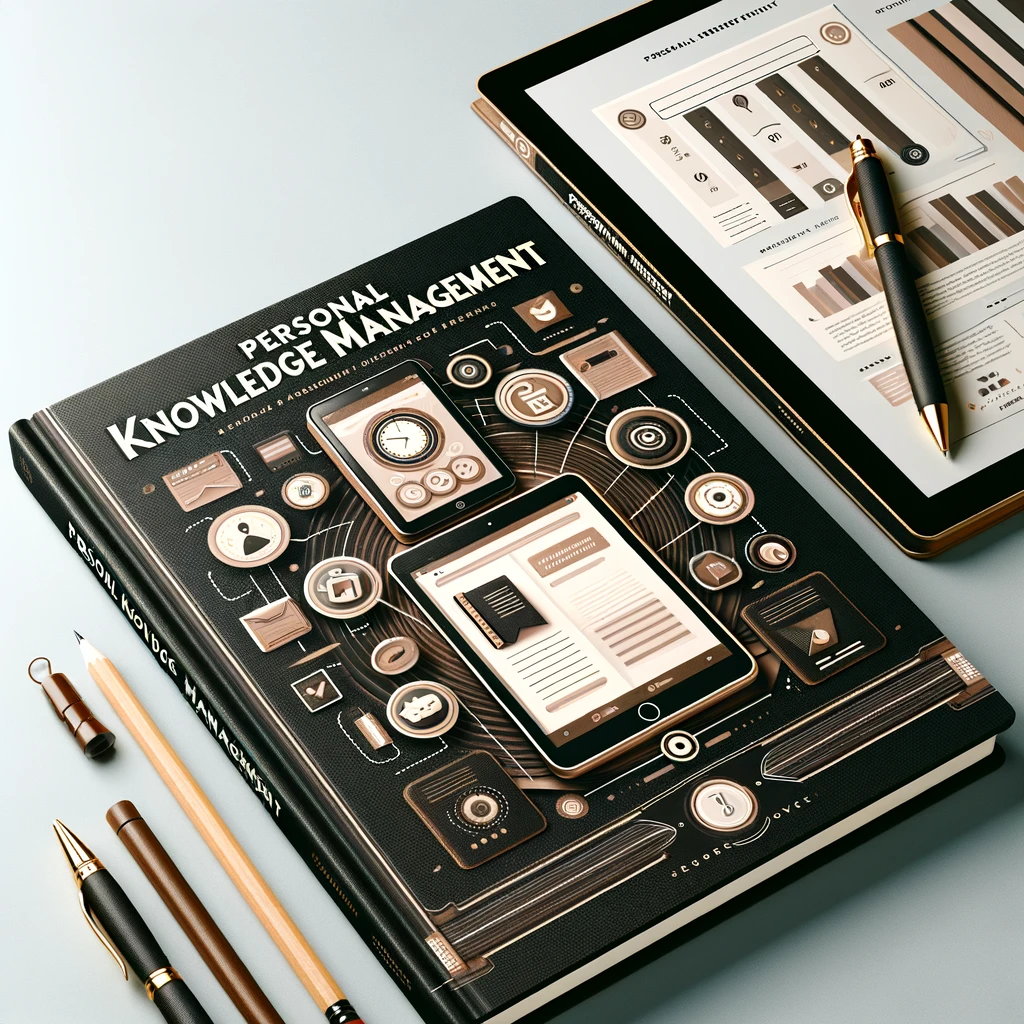
Now let's move on to the last validation exercise:
Draw a mockup by hand
You can use a tool like: tldraw on Twitter
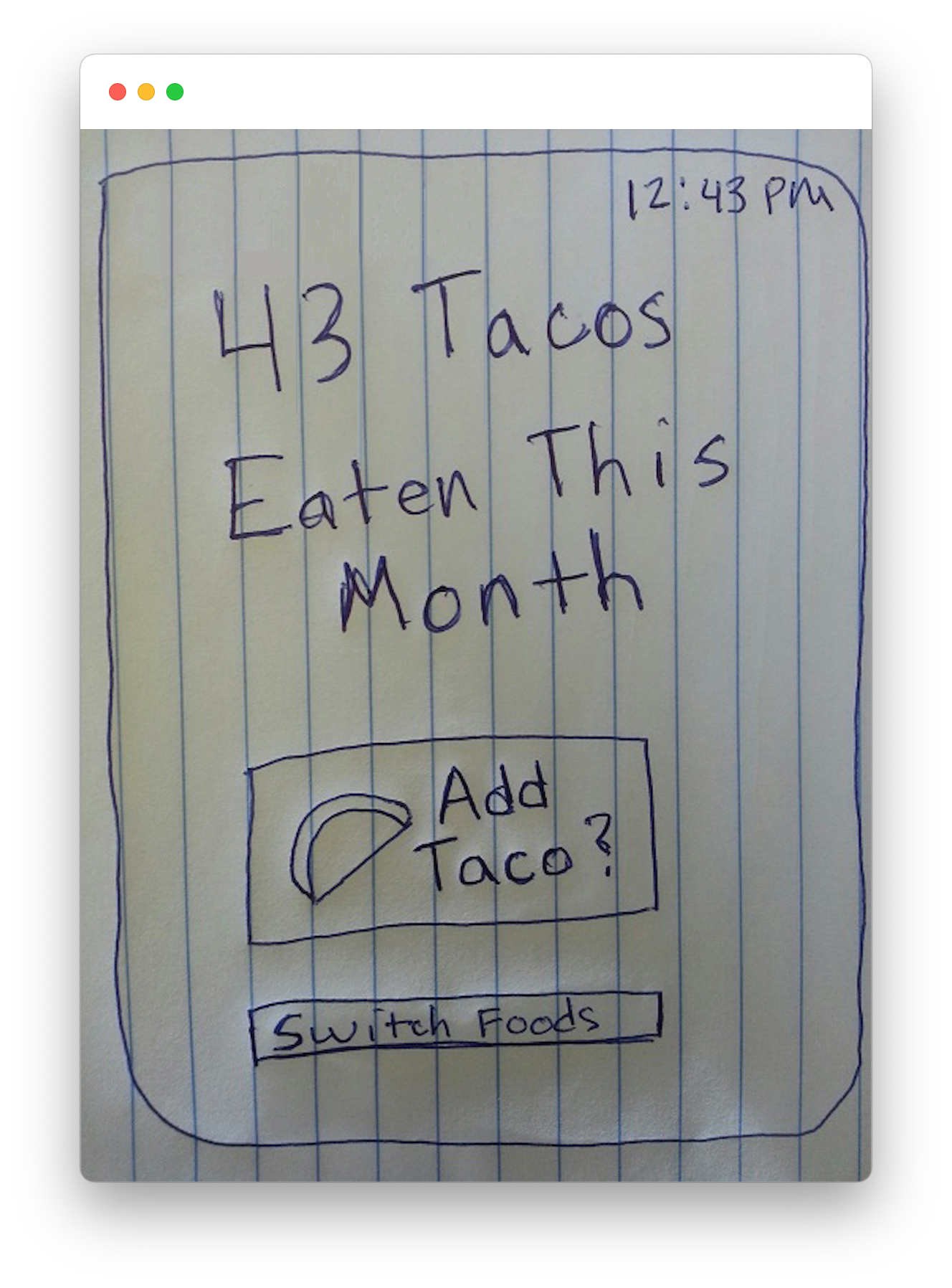
How to Validate Your Idea
The next six methods are ways you can validate your idea. As usual, remember that the biggest thing is to rank as high as possible on your customers’ totem poles.
Remember...
Avoid spending money! - paid ads can be effective, but only if you know your audience.
The key thing I’m going to drill into you is to LIMIT TIME and focus on the core of your product. Hone in on the problem you’re ACTUALLY solving.
Parkinson's law
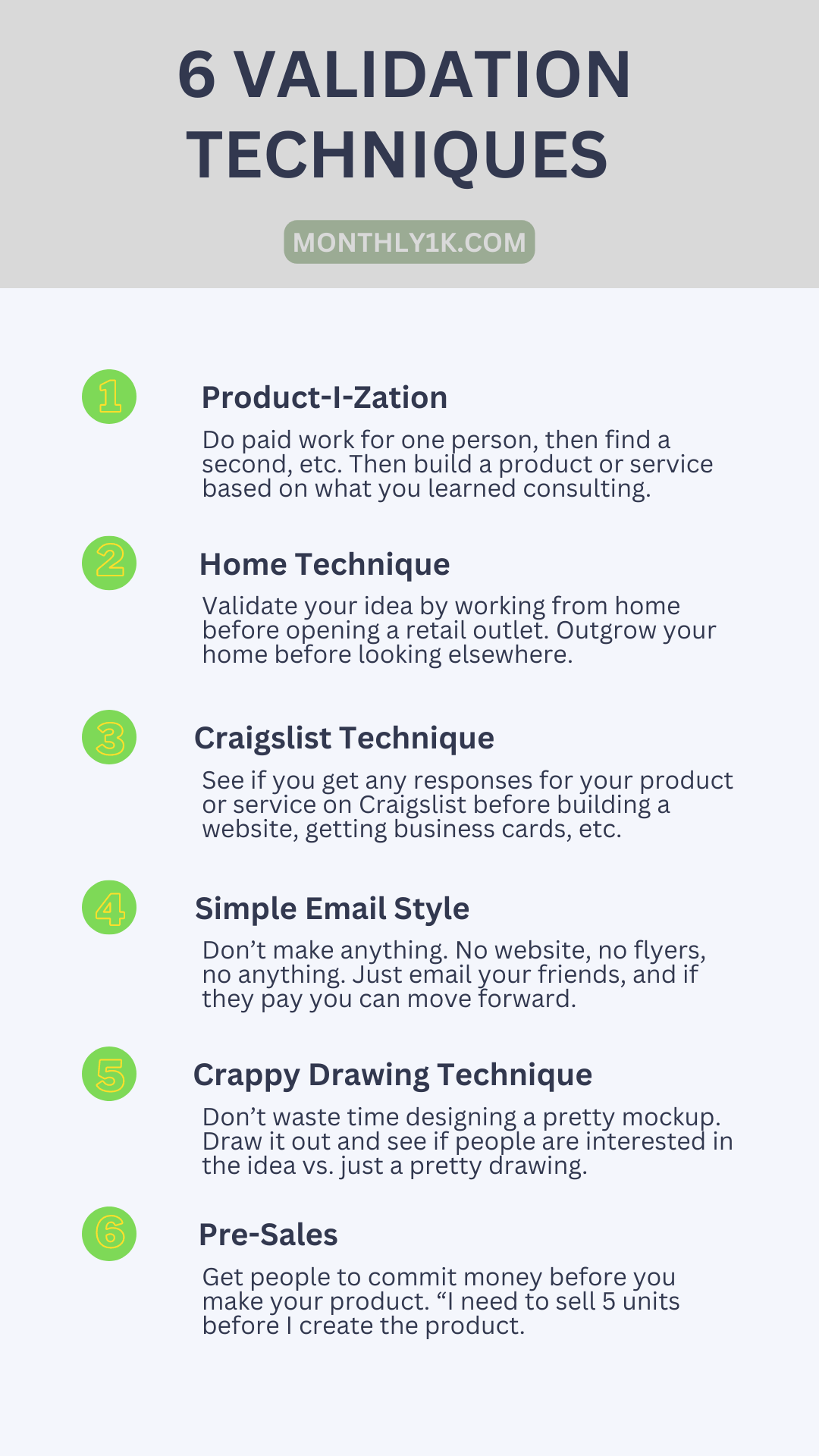
Validation Step #1: Product-i-Zation
Most people start by spending a bunch of money and time on:
- A website
- Writing a book
- Creating an online training course
Etc…
A better way to start is to help people individually (even if it’s for free).
do things that don't scale
Help people manually, one at a time.
I call this Product-I-Zation:
I perform the service for people before spending a bunch of money making a tool or app that does it.
Doing this will help you understand what problems people are facing so you can figure out the best way to help them. From there, you’ll be able to find out what they're excited to pay you for.
Once you get too busy, then you can start creating a website, course, ebook, or app.
- & Pro-tip: Keep track of the questions people keep asking you when you’re working for them. This will be helpful in creating a product or service later.
That's actually how this course was started.
In 2012, I kept manually answering emails and questions from people about how to start a business. It got pretty overwhelming, so my team and I created this product to replace me.
Too many wantrepreneurs fall into the trap of productizing right away instead of doing the service.
Only when you can't handle the amount of customers manually, should you then create the product.
The key thing is to just go help one person at a time and build up that base of customers. Everything else is a distraction.
Activity
- Can you use the Product-I-Zation method to validate?
- If yes, how would you use Product-I-Zation?
Morgan's Idea:
I can help people with their notes and journalling setup. (PKM)
I can give them the templates I use and show them ways to get started easily.
I can point them to free tools/ setup I use for voice notes into my Obsidian vault.
I can create content & a course to scale this help.
Validation Step #2: Home Technique
- validate out of your home
- create a meetup or event and ask people for money to join
- create a simple community (eg Blueprint)
Before you try to open up a retail business, use the home technique.
It’s simple: Run the business out of your home.
This is perfect for restaurants, stores, or yoga studios. Basically, anything where a physical presence is required.
Example:
My friend Carino is a professionally trained chef and was considering opening a restaurant.
The costs, risk, and time associated with doing that are very high.
So she tried the home technique and used Eventbrite to charge friends (and friends of friends) to come eat at various friend's houses.
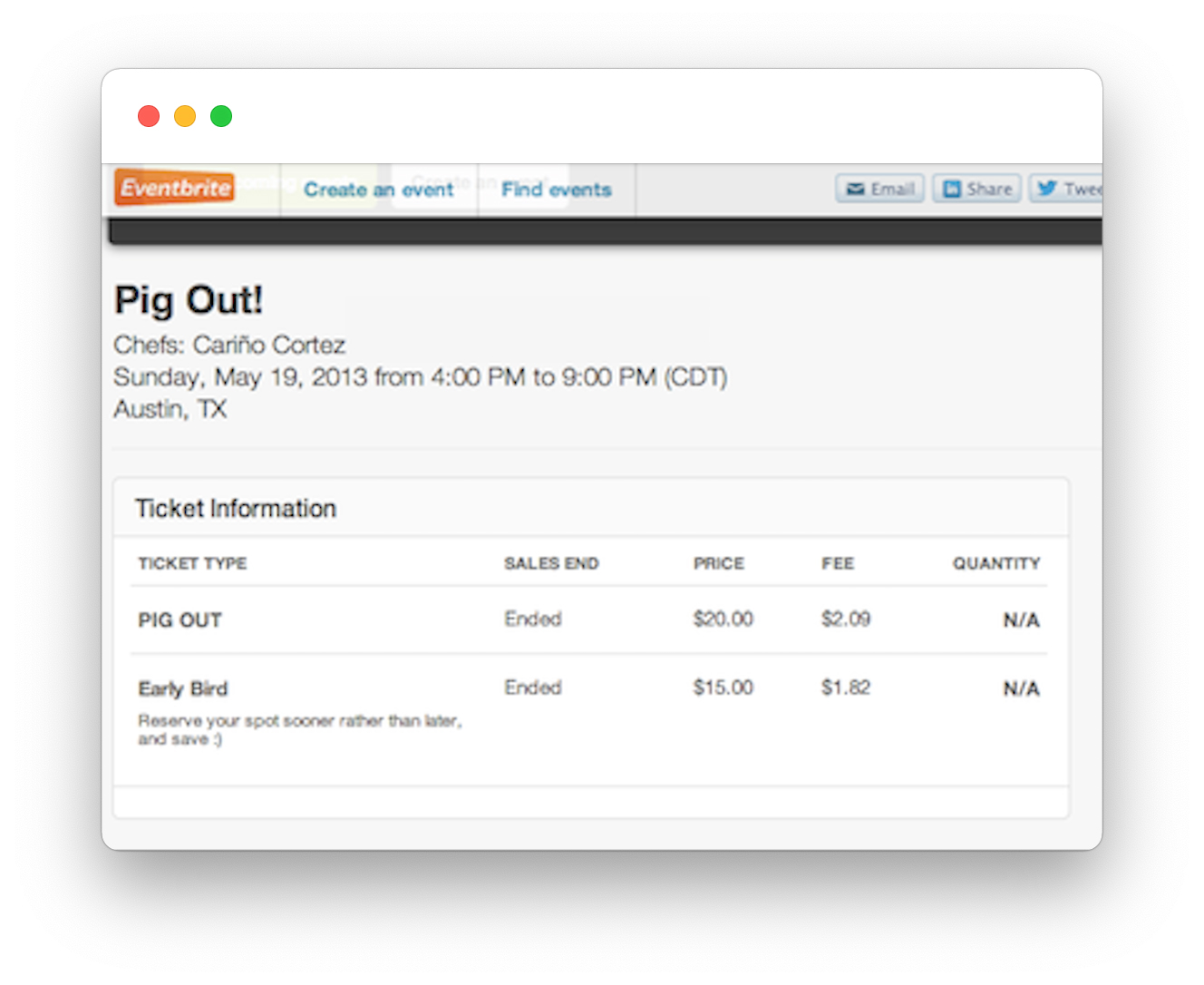
The Eventbrite page from one of her dinners.
This way, she had almost no costs, made a profit, and built a client base—and when the time is right, she’ll have a bunch of customers ready for her to open a restaurant!
You can also use a method like this to figure out the right dishes to put on your future menu.
For businesses like a yoga studio, invite friends to train at your place or at a park. Eventually, you can open a studio when you're ready.
Send a simple email/ text to friends, ask them for money for the service
Activity
- Can you use the Home Technique to validate your idea?
- If yes, how would you do it?
Validation Step #3: The Marketplace Idea
Post your idea on a Marketplace - (Craigslist, Facebook, Ebay etc. is great) as a classified listing.
This can be in any section: gigs, services, community chats, or for sale. The posting is completely free and saves you insane amounts of time validating vs. building a website, figuring out a domain, etc…
Activity
- Can you use the Marketplace to validate your idea?
- If yes, how would you do it?
Validation Step #4: Simple Email/ Message Style
Instead of making a website or marketplace, just email your friends. If they’re willing to pay for your product or service, then you can consider building a website.
This is also a really great option for marketplace types of businesses like eBay, AirBnB etc. You can manually connect people via an email list and charge for the connections. Simple.
The Boris.
My friend Boris had the idea for a marketplace where busy people can order dishes from caterers or moms who've cooked too much for dinner. Instead of doing any work, Boris emailed 20 of his busiest friends in San Francisco and asked them to PayPal him $15 and he’d cater food for their dinner on a specific night.
Eight of the 20 confirmed.
NICE.
Then he posted on Craigslist that he needed a caterer for $13/dish on the specific night. Four applied and he chose one.
This validated that people wanted this type of service.
Here’s the email template Boris sent to validate the idea…
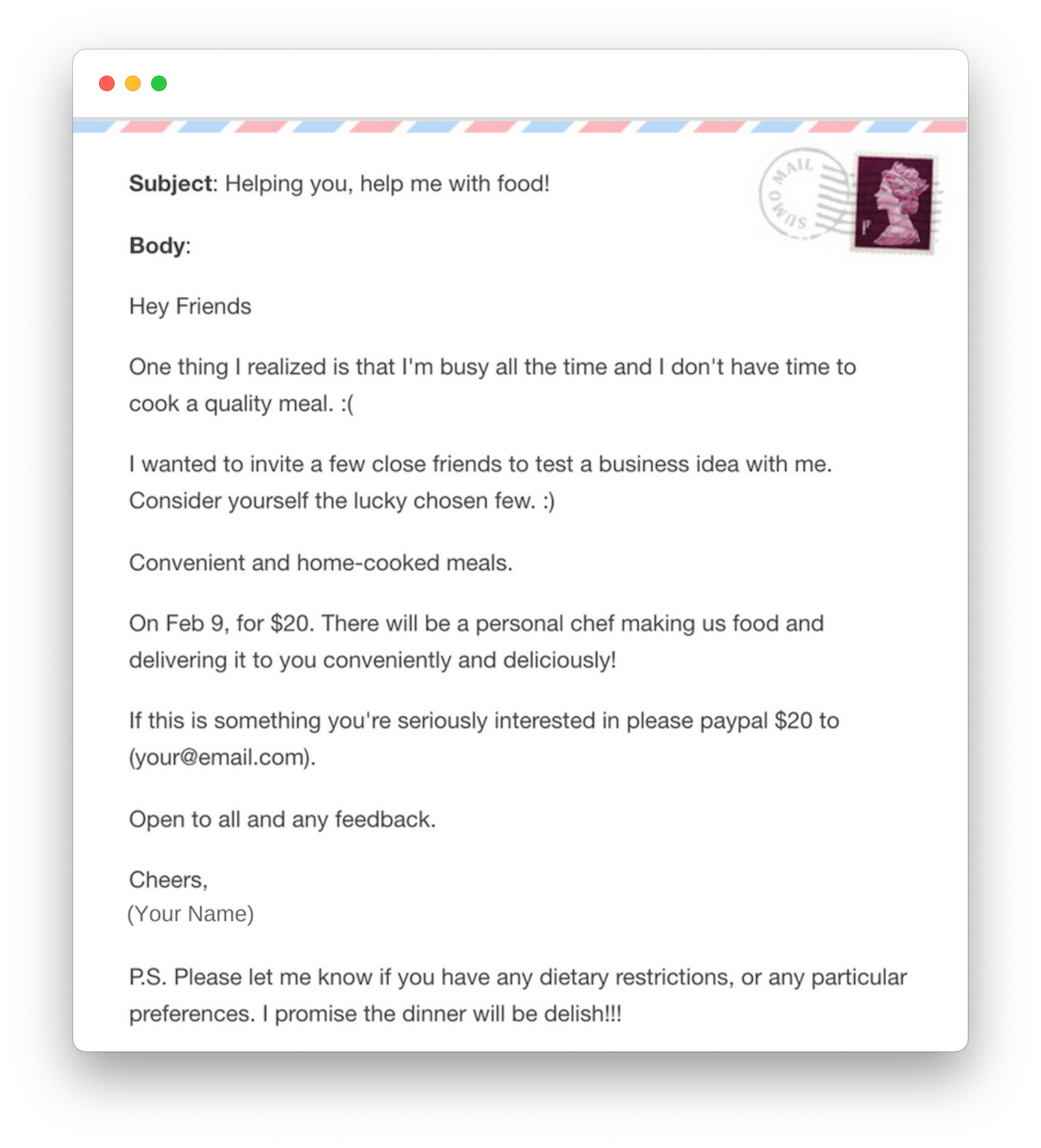
Activity
- Can you use the Simple Email Style above to validate your idea?
- If yes, then how would you use it?
Validation Step #5: Crappy Drawing
Don’t worry about hiring a fancy designer and developer to make an app and then praying for people to use it.
Draw it by hand (use Google Drawings inside Google Docs, PowerPoint, or do a basic mock-up) and save the image to your phone, or draw it on your phone in the Notes app.
Then show it to people.
For example: 520or90.com (not active anymore) wanted to see if people would be interested in an app to compare traffic on two busy freeways in Seattle. They did a quick mock-up of the service and showed it to people via their iPhones.
That was the easiest and fastest way to validate whether people wanted it (or not).
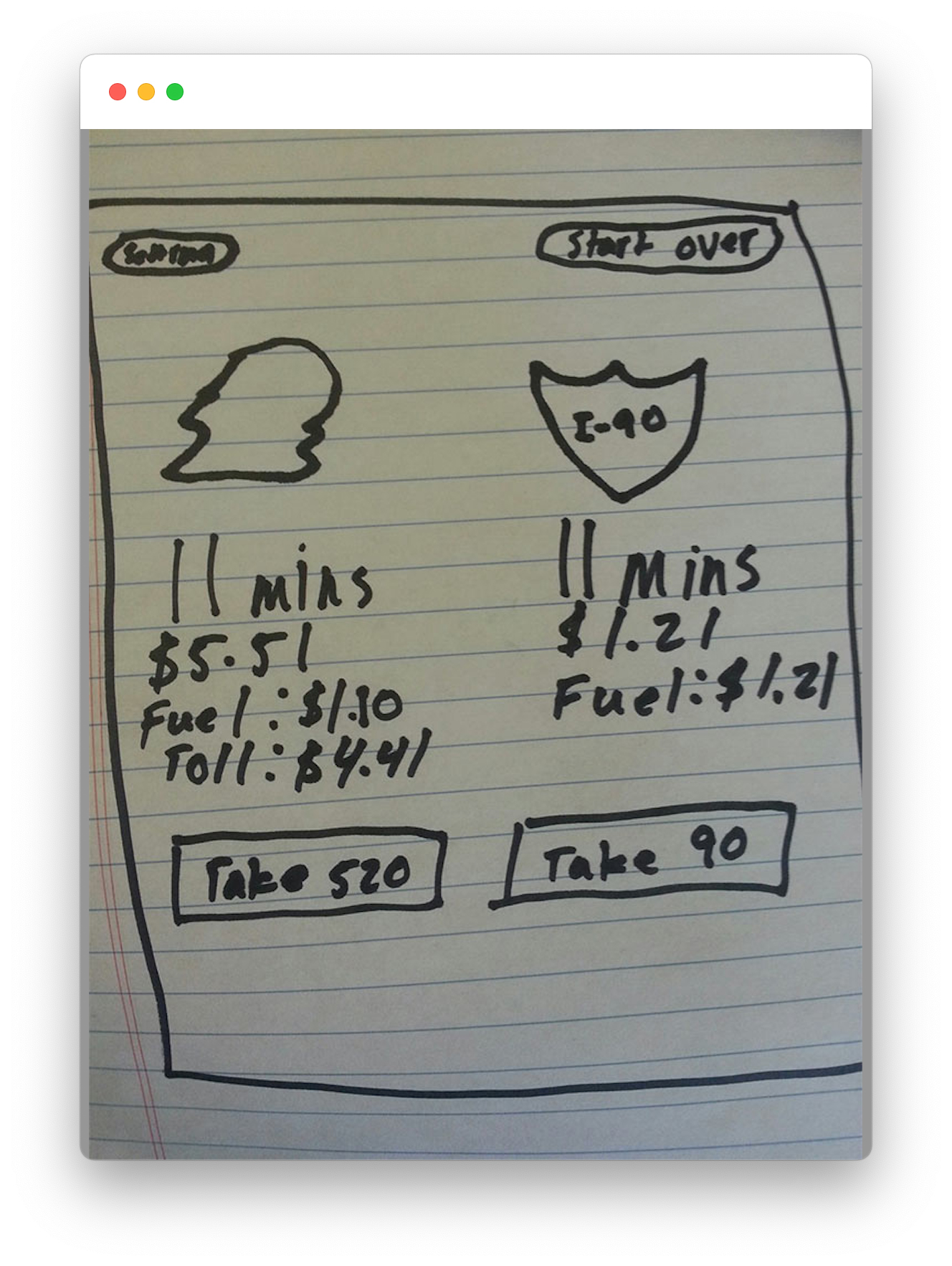
Activity
- Can you use the Crappy Drawing method to validate your idea?
- If yes, what would you make the crappy drawing of?
Validation Step #6: Pre-Sales
It’s easy to play business and imagine all the customers that will arrive once you finish creating the product.
Guess what actually happens… Crickets.
So reverse the equation and make the sales before you ever create the product! Make a goal like: "I need to sell five of them before I create the product."
If someone says no to your pre-sell, that's a PERFECT opportunity to find something that's higher on their totem pole. Ask them what they would want or use instead!
Use forums like Reddit etc. to setup pre-sale funnels.
Activity
- Can you use the Pre-Sales Technique to validate your idea?
- If yes, how would you tackle Pre-Sales?
My opinions of these validation methods
These seem to focus more on the physical products than digital.
There's very limited scale for validating (that's the point)
Creating funnels may be a better (slower) long-term strategy?!
I understand that limiting the time spent on validating how effective an initial idea might be is the key.
I bet there are better ways of doing this in <48 hrs with a higher sample rate??!
ie.
Now:
can I mockup a website in <24 hrs -> get it shown on a marketplace -> share on Reddit
I can even funnel paid traffic tests to a page and see people's behaviour, within a short period of time!
rinse and repeat!
This is the power of AI tools now.
I wonder what Million Dollar Weekend - Noah Kagan (Readwise) says about this.
I'm interested in what Daniel Priestley says about leveraging content funnels to validate and sell ideas.
eg:
Zero to $100K - How to start a business FAST - YouTube
GPT suggestions for validation
Validating digital product business ideas quickly is crucial for efficient entrepreneurship, allowing you to understand whether a concept has the potential to meet market needs without investing significant time and resources. Experts like Tim Ferriss, Noah Kagan, and Daniel Priestley offer various strategies to achieve this validation efficiently. Here are some methods inspired by their approaches:
1. Lean Testing with Landing Pages (Tim Ferriss)
Tim Ferriss, known for his work on "The 4-Hour Workweek," advocates for the lean startup methodology, which includes creating minimal viable products (MVPs) to test market hypotheses with minimal resources. A practical way to apply this within 48 hours is by setting up landing pages for your digital product with tools like Unbounce or Leadpages. These pages should offer a clear value proposition and an invitation to pre-order or sign up for a waiting list. Driving targeted traffic to these pages through paid advertising (e.g., Facebook Ads, Google AdWords) or social media can provide immediate feedback on customer interest.
2. Market Validation Through Pre-Sales (Noah Kagan)
Noah Kagan, an early Facebook and Mint employee and the founder of AppSumo, emphasizes the importance of market validation through pre-sales. Before fully developing your digital product, offer the concept for sale through a simple webpage or an email campaign to your existing network. This strategy not only tests the market demand but also secures initial funding to support further development. The key is to communicate the value and vision of the product clearly and to offer incentives for early adopters.
3. Micro-Testing on Social Media Platforms (Daniel Priestley)
Daniel Priestley, the author of "Key Person of Influence," suggests leveraging social media platforms for quick market testing. You can create posts or ads about your digital product idea, targeting specific user groups related to your market. The engagement (likes, shares, comments) and feedback received can serve as an immediate indicator of interest and potential areas for improvement. Tools like Facebook's Audience Insights can help refine your targeting to ensure your message reaches the most relevant audience.
4. Survey and Feedback Tools
Utilize survey tools like SurveyMonkey, Google Forms, or Typeform to gather feedback on your idea from your target audience. Quick, targeted surveys shared on your network or relevant online communities (including social media groups, forums like Reddit, or professional networks like LinkedIn) can yield valuable insights into customer needs and preferences.
5. Minimum Viable Product (MVP) Development
Develop a basic version of your product that showcases its core functionality. This MVP can be shared with a select group of potential users for feedback on usability, desirability, and value. Tools like GitHub for software or WordPress for web-based services can facilitate quick MVP development.
6. Competitive Analysis
Spend time researching existing solutions to the problem your digital product aims to solve. Understanding your competitors' strengths and weaknesses can help validate your product's unique value proposition and identify gaps in the market.
Implementation and Next Steps:
- Rapid Execution: Given the 48-hour constraint, select the method(s) you can implement the fastest while reaching the most relevant audience for your product.
- Measure and Iterate: Use analytics tools to measure engagement and conversion rates from your validation efforts. This data will guide your decision on whether to pivot, iterate, or proceed with the development based on user feedback and interest.
Remember, the goal of these rapid validation techniques is not only to assess market interest but also to gather actionable feedback that can refine your product idea before committing significant resources to its development.
Lessons learned through these validation techniques
- time is of the essence - apply Parkinson's law and constrain your creativity to validation!
- fail fast! - bad ideas need to burn quickly
- message people wherever they are - go to them - leverage your network, be open and honest, the intention is improving their lives
- validate, validate, validate - and ask for feedback
- identify what's highest in your customers' Totem Poles.
Doubts
You may have some doubts during validation. It’s one of the most challenging parts of starting your business.
Here are some common things you may face and the solutions to them.
Doubt #1: “I’m tired of bugging my friends to buy my product”
When you recommend a restaurant to a friend, are you bugging them or helping them out?
Exactly.
Most likely, you’re approaching friends when your idea isn’t relevant to them. Take time to think about who has the problem you’re solving before you contact all of your network.
Make sure to reach out to the right friends. And if they're really your friends, they should WANT to help you. If they won’t, then why would random strangers?
Doubt #2: “But I definitely need to build an app to validate this idea”
You’ve only spent tons of hours with us realizing you don’t. MAKE SURE to really focus on solving the problem you’re offering manually for as long as possible.
No one wants an app or a website. They want a solution to their problem.
Figure out a way to solve the problem manually. For example, if you want to create a website to help people track billable hours, can you manually watch a friend and track their hours or have them install RescueTime? It’s free.
If you want to create a marketplace website (eventually), could you connect people manually via email, Facebook group, or a Google spreadsheet to start?
I don’t want to discourage you from building a website or app, but don’t default to that. Those technologies should help scale the hard part of the business which is getting customers.
Doubt #3: “No one wants to buy my product”
That’s a great thing. Now is your time to learn and find something higher up on the customer’s totem pole.
Ask those people right away:
- Why didn’t they want to buy it?
- What things today do they need help with?
You completed the Failure Olympics challenge in one of the first sections, so rejection shouldn’t faze you. But now you can go and turn those rejections into business opportunities.
Doubt #4: “I still don’t like any of my ideas.”
This is a common fear from people not wanting to get rejected.
Look at the validation process as a learning experience instead of starting a business. You’re equipping yourself with the abilities and skills to start any business you want, now and in the future.
Try choosing the first idea on your list and just practice the validation experience.
Doubt #5: “I’ve only made two sales in 48 hours.”
Great! Go make some more.
The point of making three sales in 48 hours is to limit your time and increase your creativity. I want to discourage people from saying they need weeks to finally get a customer. The time is more a guideline than a hard rule to assist you in getting your business started.
Doubt #6: “I’ve sold once, but can’t find any more buyers.”
You’re likely being too passive.
One post on a forum (Facebook or Craigslist) and waiting for orders to roll in is not the solution.
Be active with reaching out to potential customers. No customers will ever just show up on your doorstep to begin with.
Failure is the only option!
Use failure.
Let it fuel you.
Journal and be introspective on WHY you failed.
Be better!
Your failure is not who you are—it's a part of the process of business. Keep persisting to find an idea that’s fun and more likely to succeed.
Validation Guidelines
You're going to start validating on the next page, but before we get there, you MUST follow these guidelines:
- Limit yourself to 48 hours: If it's hard to get any customers in 48 hours, it will only get harder with more time
- Don't spend any money: The point of validation is to make sure people want what you're creating—not to waste money
- Three paying customers: People "promising" to pay is not something you can cash at the bank. Actual money needs to be received. We've found that three people is the ideal number of customers to ensure that growing the business will be easy for you.
- Skin your knee, then ask for help: You'll learn the most from trying and doing vs. defaulting to asking for help. If you do need ANY help, we’re here for you. Post in the Facebook Group for support.
Overall, if your validation doesn't work, don't sweat it. The main thing is making sure you aren't wasting time and money on something nobody wants
Validation Toolbox
For the following questions, think about the product you wanted to validate and consider your response.
Question #1: Which of these techniques were you going to use to validate?
Question #2: How did you describe your ideal customer?
Remember Lisa, the muesli maker?
She described her ideal customers as 25-32-year-old males based in NYC who make six figures.
She eventually found out that wasn’t true. But, she found that out because she validated her product with that market… And it didn’t work! She then used that information to find out who her exact ideal customers are.
Start out your validation process by answering these questions. It’s fine if the answer changes as you gather more info from your audience. That’s all part of the validation process.
- How would you describe the customer for this idea? (Example: My customer lives within 30 miles, is male, 35-40 years old, makes around $60,000, and is a carpenter.) Use your intuition to determine the specifics at first—you can refine later. Who do you think is the MOST likely person to buy this product? Are they young or elderly? Live in the area or will they buy online? Do they have a lot of disposable income or not? If you can’t define who will—then work backward by defining who won’t.
- What is the problem this customer is facing? (Example: The problem they’re facing is that it's hard for them to find cheaper building materials.)
- Why is this problem important for this customer? (Example: It's important to them because it'll help them save a lot of money.)
Question #3: Where can you find the first three customers? Good question!
- Email all your friends, family, and colleagues about your idea
- Reach out to one at a time. Call, meet in person, or text relevant friends who you think will be interested.
- Ask those friends and family for anybody who may need your service or product
- Text friends you think would be interested
- Post on Facebook, LinkedIn, or Twitter
- Create an event on Eventbrite and see if you can get people to pay to register (food, class, workshop, etc.)
- Get inspired by reading how others got their first three customers
- Bottom line: Reach out to anyone in every way possible
Question #4: Pricing
Don't sweat it too much. If you don't know what to charge, just go with $10. Simple. You can always raise your prices later.
A good rule of thumb: If you know how much money you’re going to save or make someone, charge 1/10th of that.
If you're validating a physical product, be sure you at least calculate some of your costs to ensure you break even.
Question #5: Selling Issues?
If you're struggling with sales, then watch this sales training video. I did.
If someone doesn't want to buy, listen to what you CAN help them with.
If you hit three customers within 10 minutes…
- You're a superstar
- Get as many customers as you can until 48 hours is up
Remember, this is going to be fun!
(not covered):
- estimate the TAM
- define the audience a little better
- create a repeatable framework for validating ideas in 48 hrs